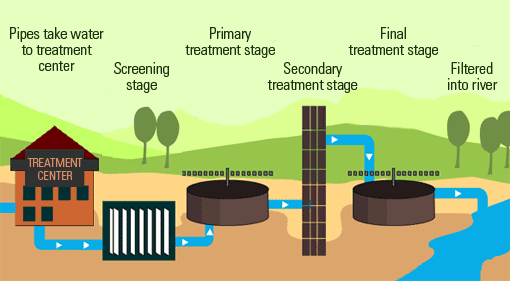The Importance of Chemical Processes in Waste Water Treatment
The Importance of Chemical Processes in Waste Water Treatment
Blog Article
Strategic Approaches to Improve Waste Water Treatment Performance and Lessen Environmental Influence
In the world of waste water treatment, the pursuit for boosted performance and decreased environmental effect is a perpetual challenge that requires tactical solutions. As society faces the critical to handle water resources sustainably, a nuanced strategy becomes essential. The combination of innovative therapy modern technologies, energy-efficient processes, resource recovery strategies, boosted nutrient elimination techniques, and wise monitoring and control systems stands for a diverse framework for addressing these pressing worries. What lies at the core of this complicated internet of strategies is the possible to reinvent the method we come close to waste water treatment, not just as a procedure of disposal, however as an important opportunity for innovation and environmental stewardship.
Advanced Treatment Technologies
Sophisticated membrane layer filtering systems have actually reinvented innovative wastewater treatment processes, significantly boosting the elimination of contaminants. This innovation has verified to be highly efficient in removing a wide range of pollutants, consisting of pharmaceuticals, heavy metals, and natural substances, which are typically challenging to get rid of via standard therapy methods.
In addition, membrane filtering systems use various benefits over conventional treatment strategies. They need much less space, produce higher-quality effluent, and are a lot more immune to variations in influent water high quality. Additionally, these systems are very flexible and can be quickly incorporated right into existing treatment plants or used as standalone devices for decentralized applications. As the demand for clean water continues to rise, the adoption of sophisticated membrane purification innovations is important to make sure reliable and lasting wastewater treatment techniques.
Energy-Efficient Processes
The combination of energy-efficient processes in wastewater treatment systems is crucial for maximizing resource application and minimizing functional expenses. By applying energy-efficient technologies, treatment plants can significantly decrease their carbon footprint and total environmental influence. One essential approach to boosting power effectiveness in wastewater treatment is the use of advanced oygenation systems, such as great bubble diffusers or surface aerators, which can enhance oxygen transfer efficiency and decrease energy intake. Additionally, including energy recuperation systems, like anaerobic food digestion for biogas production or utilizing excess warm for thermal processes, can aid balance out power requirements and advertise sustainability.
In addition, maximizing procedure control and automation via making use of sophisticated sensing units and monitoring systems can improve general power performance by adjusting procedures in real-time based upon actual demand and conditions. Applying power audits and consistently keeping an eye on energy performance indications are vital methods to determine areas for renovation and track energy-saving efforts successfully. Generally, the adoption of energy-efficient processes in wastewater treatment not just profits the setting yet additionally adds to lasting price savings and operational sustainability.
Resource Recuperation Approaches
With a concentrate on enhancing resource application and sustainability in wastewater therapy systems, the execution of source healing strategies becomes an essential aspect in improving operational performance. Source healing strategies in wastewater official statement treatment involve the identification and extraction of valuable sources from the waste stream, therefore transforming what was as soon as thought about waste into a useful asset. By implementing resource healing methods such as nutrient elimination and healing, power generation from organic issue, and the manufacturing of reusable water, wastewater therapy plants can reduce ecological effect while optimizing efficiency.

Enhanced Nutrient Elimination Techniques
Executing innovative nutrient elimination methods is essential for maximizing the efficiency of wastewater therapy systems. One of the key strategies utilized for improved nutrient removal is the process of organic nutrient removal (BNR), which includes the elimination of nitrogen and phosphorus with organic processes.

In addition to BNR, advanced therapy approaches such as membrane layer bioreactors (MBRs) and built marshes can also be utilized to improve nutrient removal effectiveness. MBRs utilize membrane layers to accomplish premium effluent standards by successfully removing nutrients and suspended solids. Created wetlands mimic all-natural wetland processes to eliminate nutrients via plant uptake, microbial task, and sedimentation. By integrating these advanced nutrient elimination strategies into wastewater treatment towns, systems and markets can effectively reduce nutrient pollution and protect the environment.
Smart Surveillance and Control Solution
Utilizing find out here innovative technology, the assimilation of wise surveillance and control systems transforms the functional performance of wastewater therapy facilities. These systems integrate innovative sensors and information analytics to constantly check key parameters such as pH levels, turbidity, dissolved oxygen, and flow rates in real-time. By gathering and evaluating this information, drivers can get useful understandings right into the efficiency of the treatment processes, making it possible for proactive modifications to visit here maximize therapy efficiency.
Smart surveillance and control systems additionally sustain remote surveillance capabilities, permitting operators to access real-time data and control functions from off-site areas. This remote ease of access boosts operational versatility and responsiveness, making it possible for swift interventions in case of system breakdowns or fluctuations in influent quality. The anticipating maintenance capacities of these systems assist stop tools failings and minimize downtime, inevitably improving the general reliability of wastewater treatment operations.
Conclusion
In final thought, strategic techniques such as advanced therapy modern technologies, energy-efficient procedures, resource recuperation techniques, enhanced nutrient removal methods, and clever surveillance and control systems play a critical duty in improving wastewater treatment efficiency and decreasing ecological impact. By carrying out these strategies, wastewater therapy plants can boost their total performance, reduce energy intake, recoup valuable resources, and make sure conformity with ecological guidelines. These techniques are essential for sustainable and effective wastewater management techniques.

In verdict, strategic approaches such as sophisticated therapy technologies, energy-efficient procedures, source recovery methods, boosted nutrient elimination methods, and clever monitoring and control systems play a critical function in boosting wastewater treatment efficiency and minimizing environmental influence.
Report this page